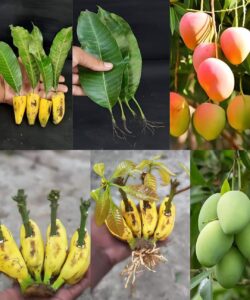How to Grow Mangoes Right From A Nursery Using Mango Leaves and Ripe Bananas
This Article Breaks Down The Step-By-Step Process To Create Your Very Own Mango Nursery From Scratch.

Uganda Today Edition: How to Grow Mangoes Right From A Nursery Using Mango Leaves and Ripe Bananas
Mangoes are beloved for their sweet, tropical flavor, but growing them can seem like a daunting task. However, with a little creativity, you can propagate mangoes in a nursery using a simple combination of mango leaves and ripe bananas. This article breaks down the step-by-step process to create your very own mango nursery from scratch.
Materials Needed:
- Healthy mango leaves
- Ripe bananas (or banana stem sections)
- Pots with well-draining soil
- Water
- Plastic bags or plastic bottles
- Small garden tools (optional)
1. Select Healthy Mango Leaves
Start by choosing healthy mango leaves from a mature tree. Look for young, disease-free leaves, as these are more likely to thrive when propagated. Ensure that the leaves are fresh and vibrant green, without any signs of pests or damage.
2. Prepare the Mango Leaves
Once you’ve selected the best leaves, cut them off the tree, leaving a small stem (about 4–6 inches long). This stem is essential as it allows the leaf to absorb nutrients during the propagation process.
3. Prepare the Banana Tree
Bananas play a crucial role in this process, as they provide nutrients to the mango leaves while also aiding in moisture retention. You can either use pieces of banana peel or cut a small section (2–3 inches) of a banana stem. Make several small slits or holes in the banana section, as these will hold the mango leaves in place.
4. Insert the Mango Leaves
Take the mango leaves you prepared earlier and gently insert the cut end of each leaf into the slits or holes you made in the banana section. Ensure the stems are securely nestled into the banana flesh, as this will allow the leaves to take in nutrients from the banana.
5. Plant the Banana and Mango Combination
Next, prepare pots filled with well-draining soil. Dig small holes in the soil where the banana and mango combination will be placed. Bury the banana section in the soil while ensuring the mango leaves remain above the surface. The banana will slowly decompose and nourish the mango leaves as they begin to establish roots.
6. Create a Humid Environment
Once planted, water the pots thoroughly to provide moisture to the soil. Cover the pot with a plastic bag or a plastic bottle with ventilation holes to create a humid environment. This simulates a mini greenhouse and helps the mango leaves stay hydrated and warm, which is ideal for root formation.
7. Place in Indirect Sunlight
Mango leaves need sunlight, but they can’t handle direct, harsh rays while still in the early propagation stages. Place your pots in a location that receives bright but indirect sunlight. This will allow the plants to receive enough light to grow without being scorched by the sun.
8. Monitor and Maintain
It’s important to monitor the soil moisture regularly. Keep the soil moist but avoid waterlogging, as this can cause rot. Check for new growth every few days. If the leaves start to wilt or brown, consider adjusting the watering schedule or light exposure.
9. Transplanting

Once you observe roots forming and new growth emerging from the mango leaves, it’s time to transplant your young plants to larger pots or directly into the ground. Make sure to choose a sunny spot with well-drained soil for optimal growth.
Final Thoughts
This method of propagating mangoes using mango leaves and ripe bananas is not only creative but also leverages the natural nutrients found in bananas to give your young plants the best start. With careful monitoring and patience, you’ll be on your way to growing your own mango tree in no time.
Give this method a try and enjoy the satisfaction of growing your own mangoes from a nursery setup at home!
By following these steps, you can cultivate healthy mango trees from a simple combination of leaves and bananas, making this an innovative and resourceful gardening method.









